The Benefits of Using Visual Aids in Meetings
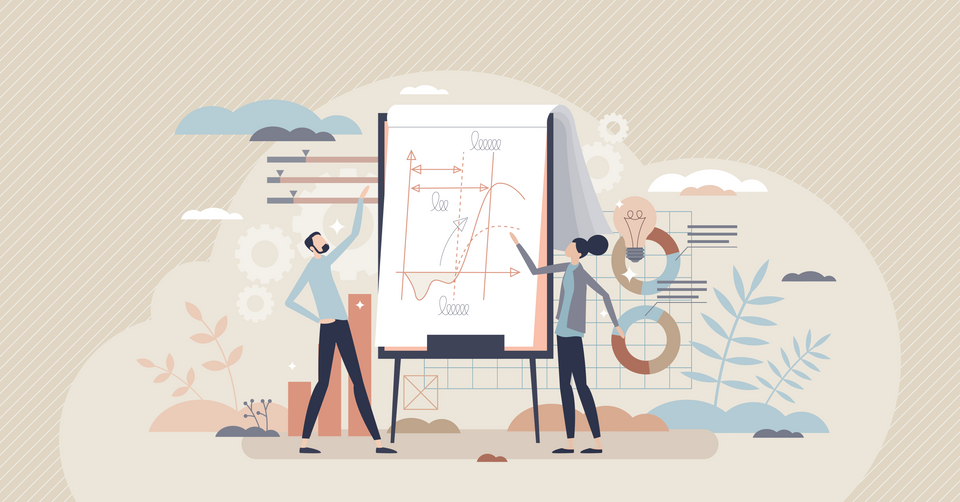
Introduction
In the world of business meetings, it's often said that a picture is worth a thousand words. This old adage highlights the importance of using visual aids in meetings to enhance communication, improve understanding, and keep participants engaged. Visual aids, ranging from simple images and graphs to interactive whiteboards and videos, can significantly elevate the quality of your meetings, leading to better outcomes and more productive teams.
In this blog post, we'll delve into the key benefits of using visual aids in meetings, demonstrating how they can transform your team's discussions and decision-making processes. We'll explore how visual aids can:
- Increase engagement: Capture and maintain the attention of your audience.
- Improve comprehension: Clarify complex information and facilitate understanding.
- Enhance retention: Help attendees remember key points and takeaways.
- Facilitate communication: Foster collaboration and productive dialogue.
- Increase efficiency: Streamline meeting processes and optimize time management.
By the end of this post, you'll have a deeper understanding of the importance of using visual aids in meetings, and you'll be equipped with practical strategies and examples to start leveraging these powerful tools in your own team gatherings.
Increased Engagement
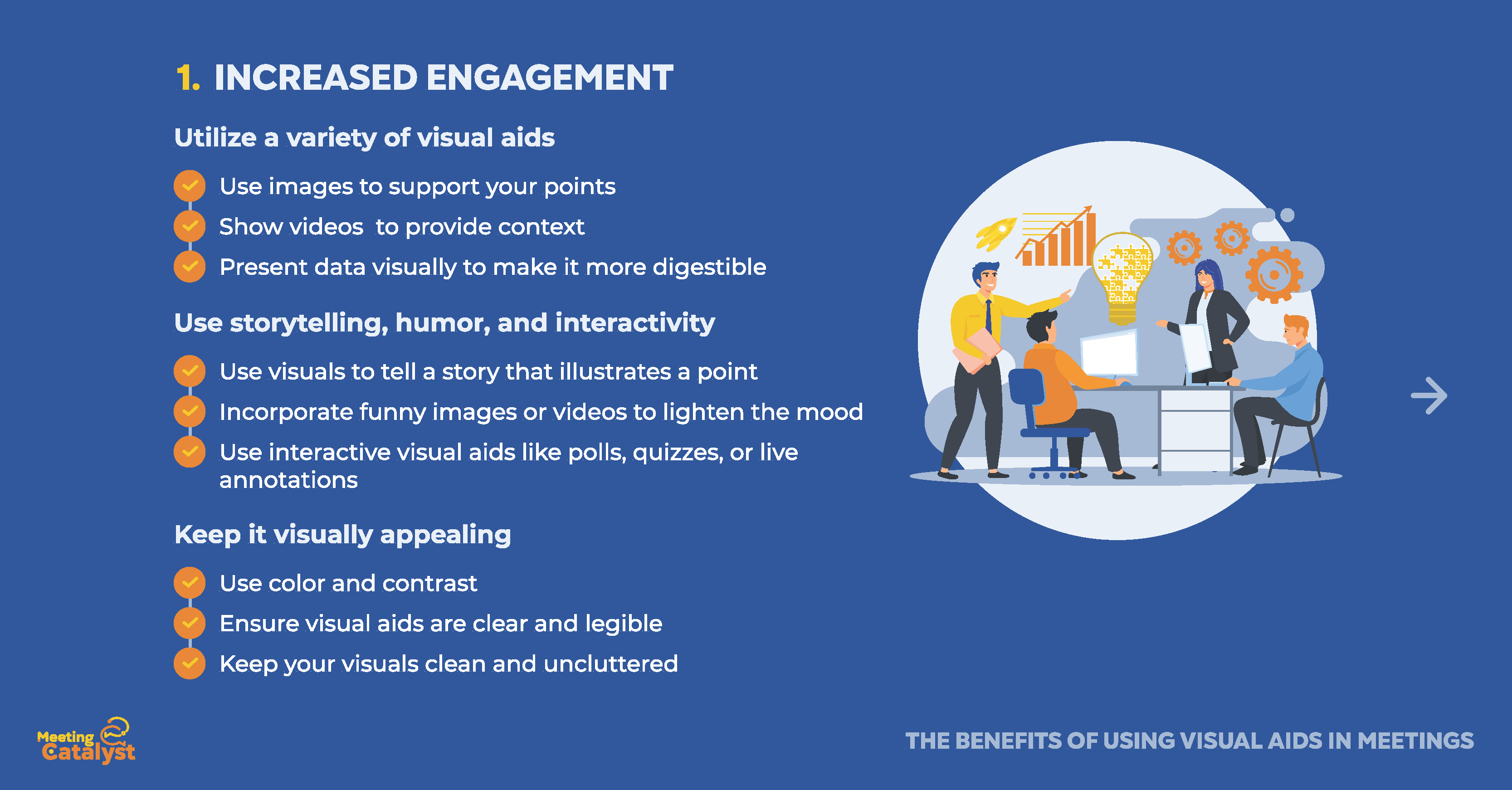
One of the most significant benefits of using visual aids in meetings is their ability to capture and maintain the attention of your audience. In a world where distractions are everywhere, and attention spans are shorter than ever, keeping your team engaged during meetings is crucial for success. Visual aids can be the key to overcoming this challenge and ensuring that your meetings are interactive, dynamic, and stimulating.
Here are some ways visual aids can help increase engagement in meetings, along with examples of effective visual aids to consider:
Utilize a variety of visual aids
Incorporating a mix of visual aids, such as images, videos, graphs, and charts, can help cater to different learning styles and keep your audience interested. For example:
- Images: Use photos, illustrations, or icons to support your points or introduce new concepts.
- Videos: Show short, relevant clips to provide context, inspire discussion, or demonstrate a process.
- Graphs and charts: Present data visually to make it more digestible and highlight trends or patterns.
Use storytelling, humor, and interactivity
Harnessing the power of storytelling, humor, and interactivity can make your visual aids more engaging and memorable. Consider these approaches:
- Storytelling: Use visuals to tell a story that illustrates a point, such as a case study or a customer journey.
- Humor: Incorporate funny images or videos to lighten the mood and keep the audience entertained.
- Interactivity: Use interactive visual aids like polls, quizzes, or live annotations to involve participants and encourage active participation.
Keep it visually appealing
Aesthetically pleasing visual aids can make your meetings more engaging by capturing the audience's attention and ensuring they are more likely to absorb the information presented. To achieve this:
- Use color and contrast to draw attention to key points and make your visual aids more visually appealing.
- Ensure visual aids are clear and legible by using simple fonts, large text, and high-resolution images.
- Keep your visuals clean and uncluttered by avoiding information overload and focusing on the most critical points.
By incorporating engaging visual aids into your meetings, you'll not only capture the attention of your team but also create a more immersive and enjoyable meeting experience that fosters participation and collaboration.
Improved Comprehension
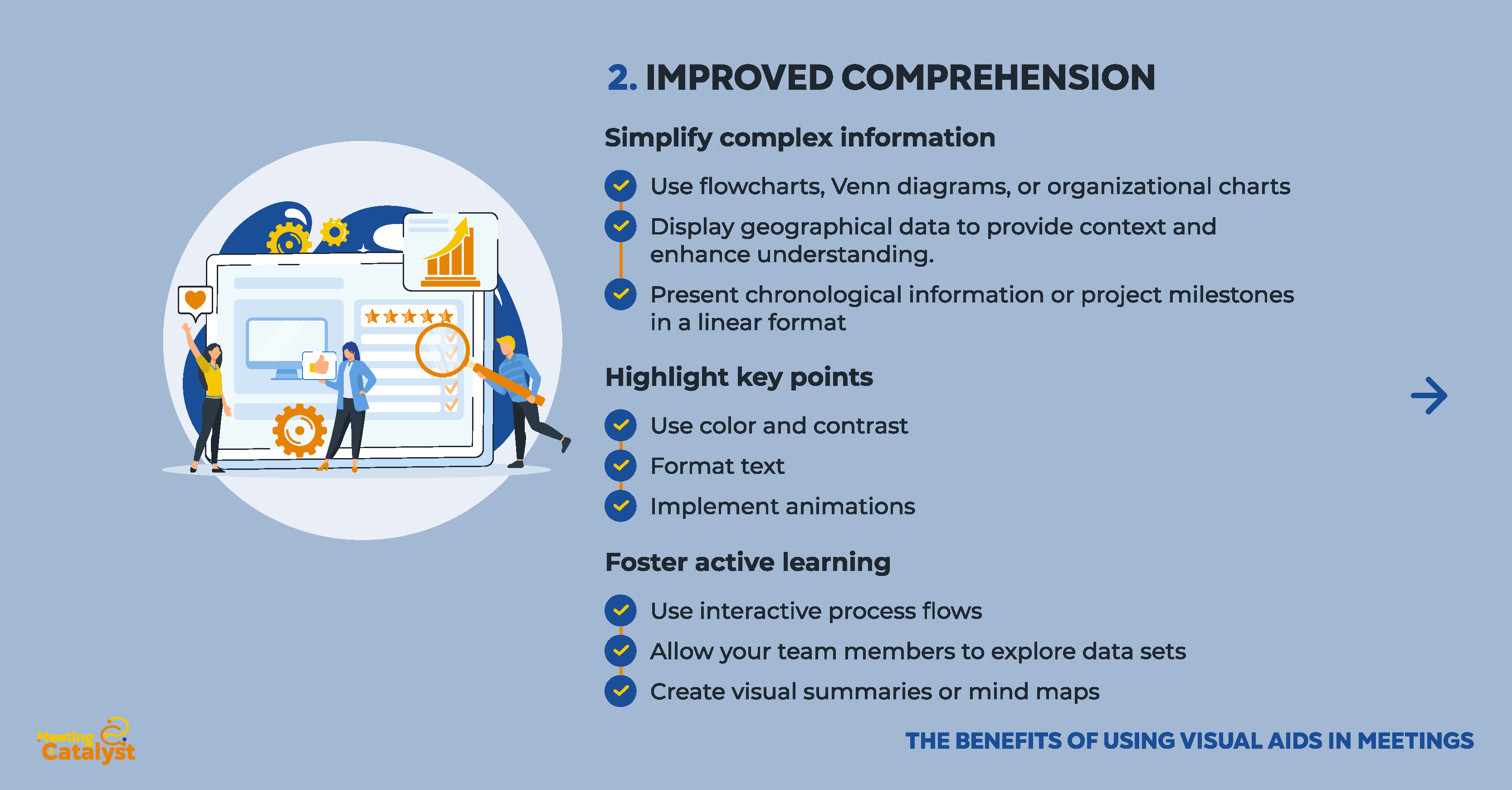
Visual aids can significantly enhance understanding and simplify complex information during meetings. By presenting information visually, you can make it easier for your team members to grasp concepts, relationships, and patterns that may be difficult to convey through words alone. Improved comprehension leads to more productive discussions, better decision-making, and increased overall meeting effectiveness.
Here are some ways visual aids can help improve comprehension in meetings, along with examples of effective visual aids to consider:
Simplify complex information
Using visual aids to break down complex information can make it more accessible and easier to understand. Some examples of visual aids that can help simplify complex information include:
- Diagrams: Use flowcharts, Venn diagrams, or organizational charts to illustrate relationships, hierarchies, or processes.
- Maps: Display geographical data, such as sales territories, distribution networks, or customer locations, to provide context and enhance understanding.
- Timelines: Present chronological information or project milestones in a linear format to show progression and visualize deadlines.
Highlight key points
Visual aids can be used to emphasize essential points and ensure that your team members focus on the most critical information. Some strategies for using visual aids to highlight key points include:
- Color and contrast: Use contrasting colors or bold formatting to draw attention to critical points, data, or trends.
- Text formatting: Emphasize key points by using larger font sizes, bold or italic formatting, or bullet points.
- Animations: Use subtle animations or transitions to reveal important information step by step and control the pacing of your presentation.
Foster active learning
Encourage your team members to interact with the information by incorporating visual aids that promote active learning. Some examples of visual aids that can help foster active learning include:
- Process flows: Use interactive process flows to help your team members understand complex systems and identify areas for improvement.
- Interactive charts: Allow your team members to explore data sets by using interactive charts that let them filter, sort, or drill down into the data.
- Visual summaries: Create visual summaries or mind maps to help your team members review and internalize key points at the end of the meeting.
By using visual aids to improve comprehension, you can ensure that your team members understand the information being presented, enabling them to participate more effectively and contribute to the overall success of the meeting.
Enhanced Retention
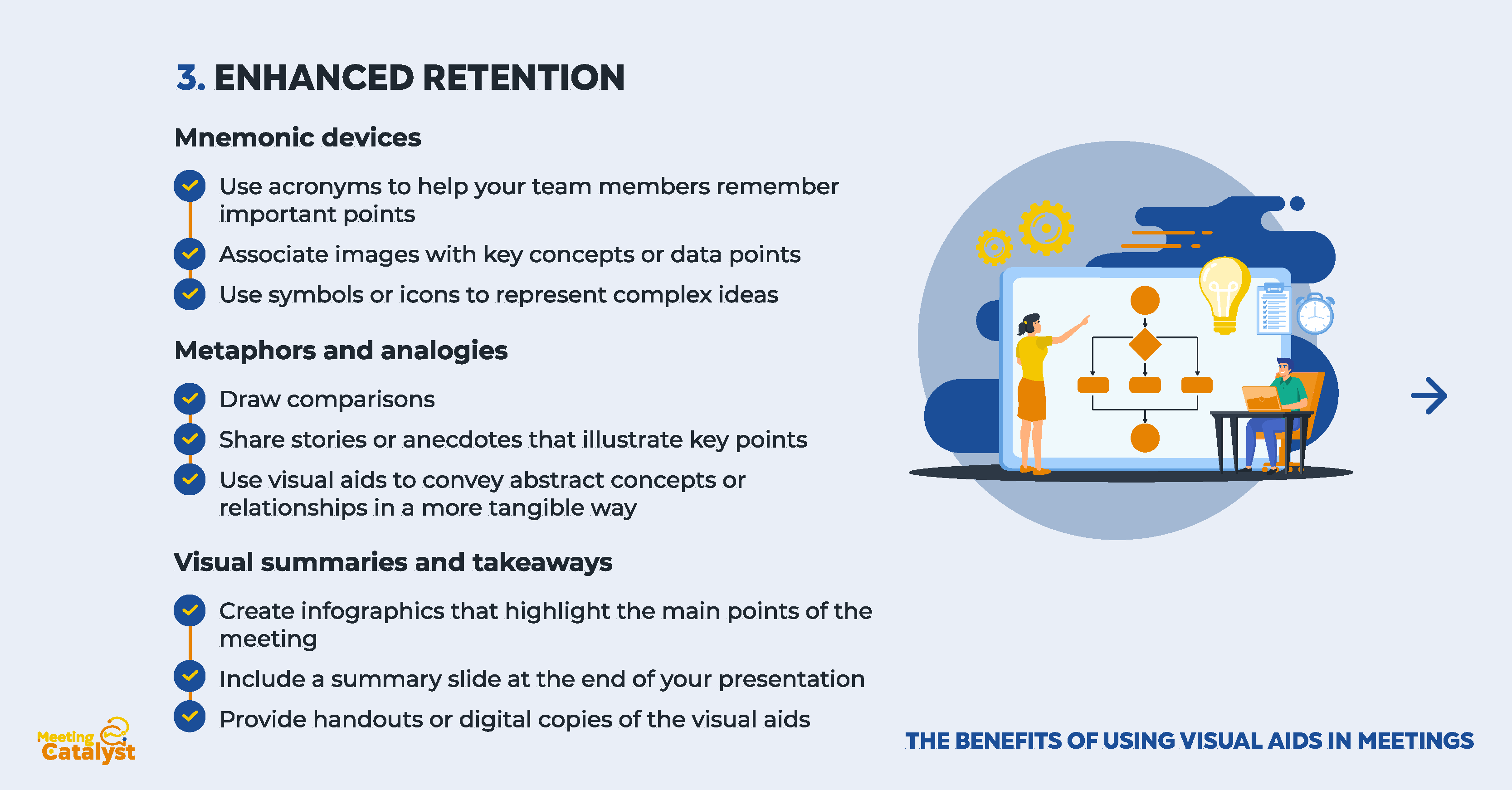
One of the key benefits of using visual aids in meetings is the improved retention of information. Research has shown that visual aids can help individuals remember information more effectively compared to text or verbal explanations alone. By incorporating visual aids into your meetings, you can ensure that your team members not only understand the information being presented but also retain it for future use and application.
Here are some ways visual aids can help enhance retention in meetings, along with examples of effective visual aids to consider:
Mnemonic devices
Mnemonic devices are visual aids that help participants remember information by associating it with easy-to-remember cues. Some examples of mnemonic devices that can be used in meetings include:
- Acronyms: Use acronyms to help your team members remember lists or sequences of information.
- Images: Associate images with key concepts or data points to create a visual representation that is easier to recall.
- Symbols: Use symbols or icons to represent complex ideas, making them more memorable and easier to understand.
Metaphors and analogies
Metaphors and analogies can help your team members relate new information to familiar concepts, making it easier to remember and apply. Some strategies for using metaphors and analogies in meetings include:
- Comparisons: Draw comparisons between the information being presented and familiar situations, objects, or ideas to create a mental connection.
- Stories: Share stories or anecdotes that illustrate key points, making them more relatable and memorable.
- Visual metaphors: Use visual aids, such as cartoons or illustrations, to convey abstract concepts or relationships in a more tangible way.
Visual summaries and takeaways
Providing visual summaries and takeaways at the end of a meeting can help reinforce key points and ensure that your team members retain the information for future use. Some examples of visual summaries and takeaways that can be used in meetings include:
- Infographics: Create infographics that highlight the main points of the meeting, making it easy for your team members to review and remember the information.
- Slide summaries: Include a summary slide at the end of your presentation that recaps the key points and takeaways for easy reference.
- Handouts: Provide handouts or digital copies of the visual aids used in the meeting, so your team members can review them later and reinforce their understanding.
By using visual aids to enhance retention, you can improve the overall effectiveness of your meetings, ensuring that your team members remember and apply the information presented in both their individual and collaborative tasks.
Facilitated Communication
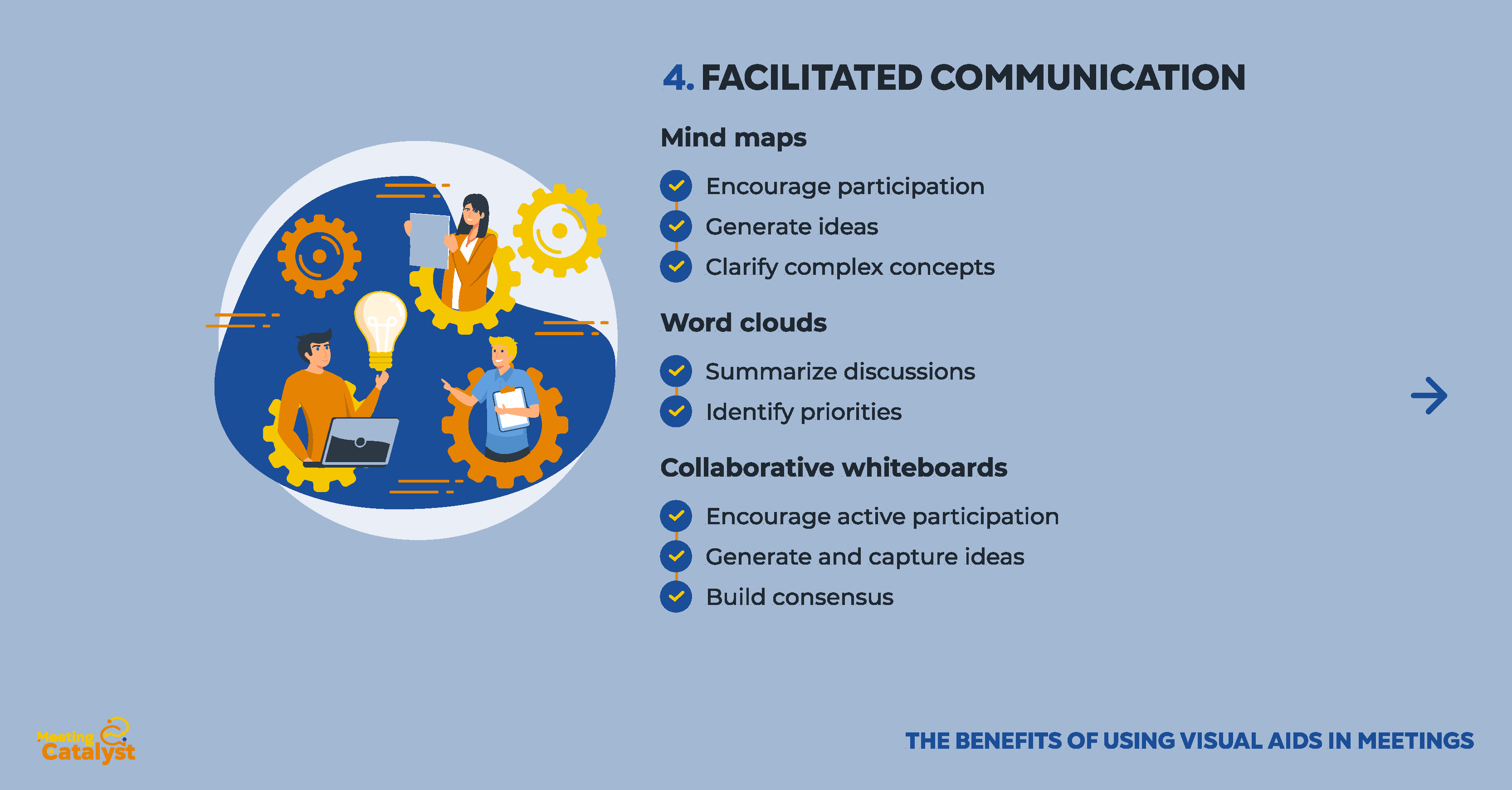
Effective communication is the cornerstone of successful meetings, and incorporating visual aids can greatly facilitate communication among team members. Visual aids can help clarify ideas, generate discussions, and build consensus, ensuring that everyone in the meeting is on the same page and working towards a common goal.
Here are some ways visual aids can help facilitate communication in meetings, along with examples of effective visual aids to consider:
Mind maps
Mind maps are visual tools that help organize and represent ideas, concepts, or information in a hierarchical structure. They can be particularly useful in meetings for brainstorming, planning, and problem-solving. By using mind maps in your meetings, you can:
- Encourage participation: Involve all team members in the process of creating and expanding the mind map, fostering collaboration and shared ownership.
- Generate ideas: Use mind maps to visually represent and connect ideas, making it easier to see relationships and generate new thoughts.
- Clarify complex concepts: Break down complex topics into smaller, more manageable pieces, making them easier to understand and discuss.
Word clouds
Word clouds are visual representations of text data, where the size of each word indicates its frequency or importance. They can be used in meetings to:
- Summarize discussions: Use word clouds to provide a visual summary of key themes and topics discussed during a meeting, making it easy for team members to review and remember the main points.
- Identify priorities: Create word clouds based on team members' input to help identify priorities, common concerns, or areas of focus for future discussions or action.
Collaborative whiteboards
Collaborative whiteboards are digital tools that allow team members to share, edit, and annotate content in real-time during meetings. By using collaborative whiteboards in your meetings, you can:
- Encourage active participation: Allow team members to contribute their ideas, questions, and feedback directly onto the whiteboard, fostering collaboration and engagement.
- Generate and capture ideas: Use the whiteboard as a shared workspace for brainstorming, problem-solving, and decision-making, ensuring that all ideas are captured and documented for future reference.
- Build consensus: Visually represent different perspectives and opinions, making it easier for team members to find common ground and reach a consensus on important issues.
By incorporating visual aids that facilitate communication in your meetings, you can create a more inclusive, collaborative, and productive environment, ultimately leading to better outcomes for your team and organization.
Increased Efficiency
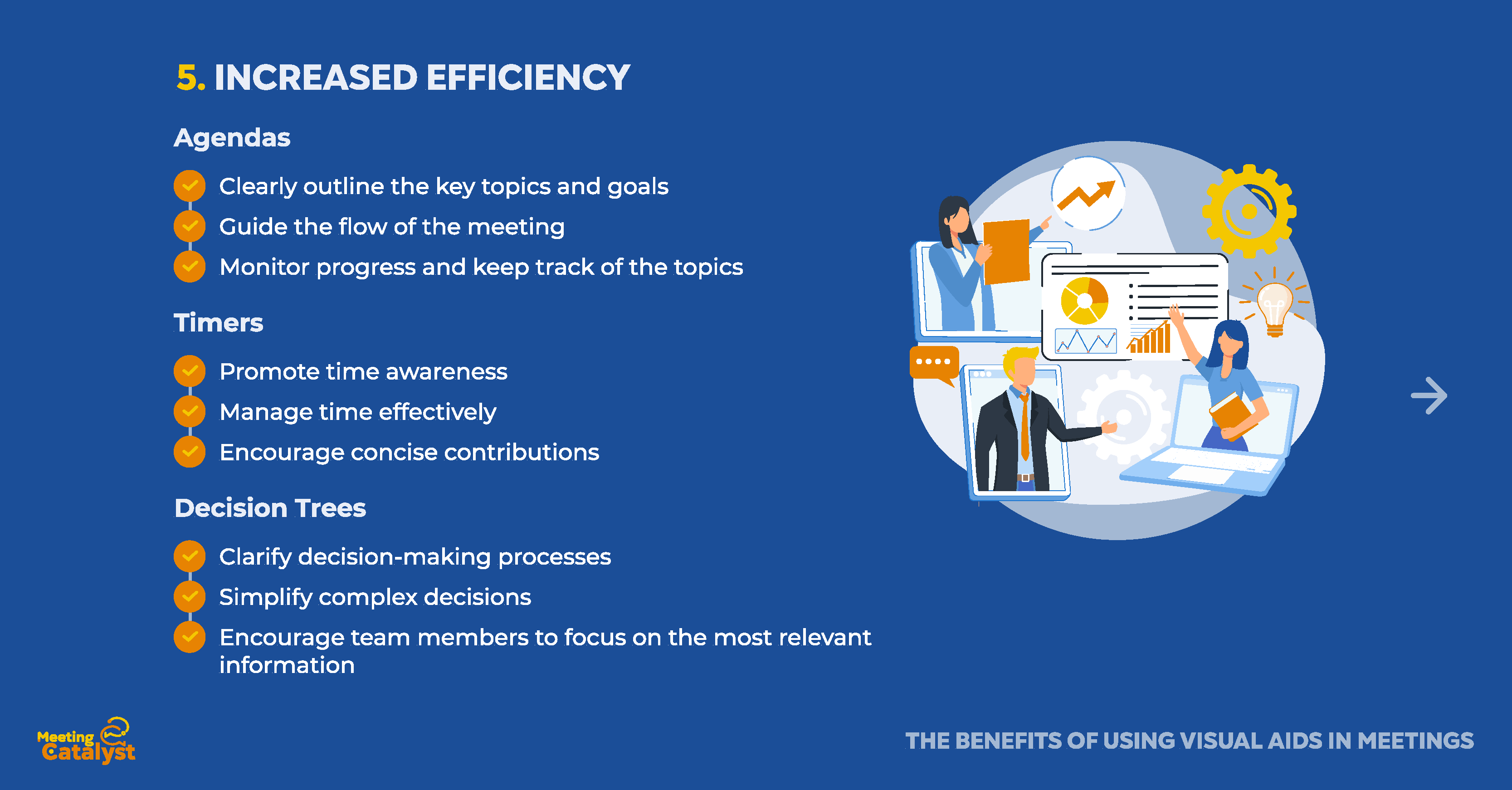
Efficient meetings save time, resources, and ultimately contribute to a more productive work environment. Visual aids can play a crucial role in increasing efficiency during meetings by helping to set clear objectives, manage time effectively, and provide guidance to keep everyone on track.
Here are some examples of visual aids that can help increase efficiency in meetings and tips on how to use them effectively:
Agendas
A visual agenda displayed on a screen or whiteboard helps to set the structure and objectives for the meeting. By using a visual agenda, you can:
- Establish priorities: Clearly outline the key topics and goals for the meeting, ensuring that everyone is focused on the most important issues.
- Guide the flow of the meeting: Help participants understand the order of discussion and anticipate what's coming next, allowing them to prepare their thoughts and contributions.
- Monitor progress: Keep track of the topics covered and remaining, making it easier to adjust the pace or allocate additional time if needed.
Timers
Using a visible timer during meetings can help ensure that discussions stay within the allotted timeframes. By displaying a timer, you can:
- Promote time awareness: Encourage participants to be mindful of the time they spend on each topic or task, helping to maintain focus and avoid lengthy digressions.
- Manage time effectively: Allocate specific time slots for each agenda item and adjust the pace of the meeting as needed to stay on schedule.
- Encourage concise contributions: Prompt team members to share their thoughts and opinions succinctly, preventing long-winded discussions and promoting equal participation.
Decision Trees
Decision trees are visual tools that help guide decision-making by displaying possible choices, outcomes, and consequences in a branching format. By using decision trees in your meetings, you can:
- Clarify decision-making processes: Make it easier for participants to understand the various options and potential outcomes, promoting informed decision-making.
- Simplify complex decisions: Break down complex decisions into smaller, more manageable steps, facilitating discussion and evaluation of each option.
- Reach decisions faster: Encourage team members to focus on the most relevant information and weigh the pros and cons, ultimately leading to quicker and more efficient decision-making.
By incorporating visual aids that increase efficiency in your meetings, you can make the most of your team's time and resources, leading to more productive and successful outcomes for your organization.
Overcoming Challenges
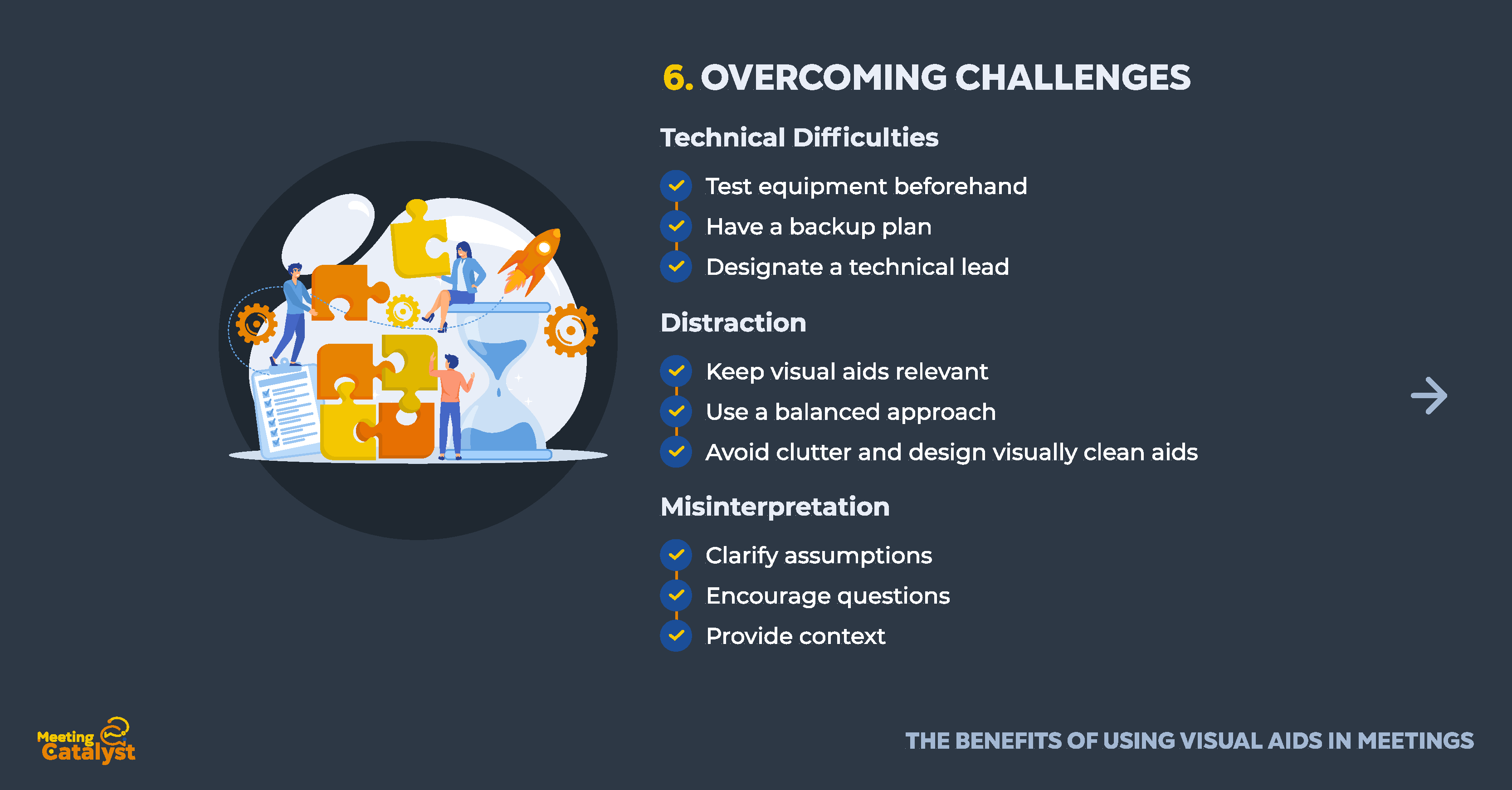
While using visual aids in meetings can offer numerous benefits, it's essential to acknowledge and address the challenges that may arise. By understanding these challenges, you can implement effective strategies to overcome them and ensure that your visual aids contribute positively to your meetings.
Technical Difficulties
Visual aids often rely on technology, which can sometimes malfunction or cause unexpected delays. To overcome technical difficulties:
- Test equipment beforehand: Make sure all devices, such as projectors, screens, or software, are in working order before the meeting starts.
- Have a backup plan: Prepare alternative options in case of technical issues, such as printed handouts or a backup device.
- Designate a technical lead: Assign someone to handle any technical issues that may arise during the meeting, allowing the rest of the participants to stay focused on the agenda.
Distraction
Inappropriate or excessive use of visual aids can distract from the main points of the meeting. To minimize distractions:
- Keep visual aids relevant: Ensure that each visual aid contributes meaningfully to the discussion and avoids unnecessary information.
- Use a balanced approach: Combine visual aids with verbal communication and other forms of interaction to engage participants without overwhelming them.
- Avoid clutter: Design visually clean and straightforward aids that are easy to understand and focus on the key points.
Misinterpretation
Visual aids can sometimes be misinterpreted or misunderstood, leading to confusion or miscommunication. To avoid misinterpretation:
- Clarify assumptions: Make sure that all participants understand the context, assumptions, and key points of each visual aid.
- Encourage questions: Invite participants to ask questions or seek clarification on any aspect of the visual aid that may be unclear.
- Provide context: Offer explanations, background information, or real-life examples to help participants better understand the visual aids and their relevance to the meeting topic.
By anticipating and addressing these challenges, you can ensure that your visual aids effectively support your meeting objectives and contribute to a more engaging, productive, and efficient meeting experience.
Conclusion
Incorporating visual aids in your meetings can greatly enhance the overall experience for all participants, leading to more effective and productive discussions. By utilizing visual aids, you can:
- Increase engagement: Visual aids capture the attention of participants, making the meeting more interactive and enjoyable.
- Improve comprehension: Visual aids simplify complex information and help participants grasp key points more easily.
- Enhance retention: By reinforcing important points and facilitating recall, visual aids promote better retention of meeting content.
- Facilitate communication: Visual aids foster collaboration, idea generation, and consensus-building among participants.
- Increase efficiency: Visual aids help set clear objectives, manage time effectively, and provide clear guidance for meeting participants.
As you integrate visual aids into your meetings, remember to anticipate and address potential challenges, such as technical difficulties, distractions, and misinterpretation. By doing so, you can ensure that your visual aids contribute positively to your meetings and support your objectives.
Now is the time to embrace the power of visual aids in your meetings. Start by exploring various types of visual aids and experimenting with different techniques to create a more engaging, productive, and memorable meeting experience for all participants.